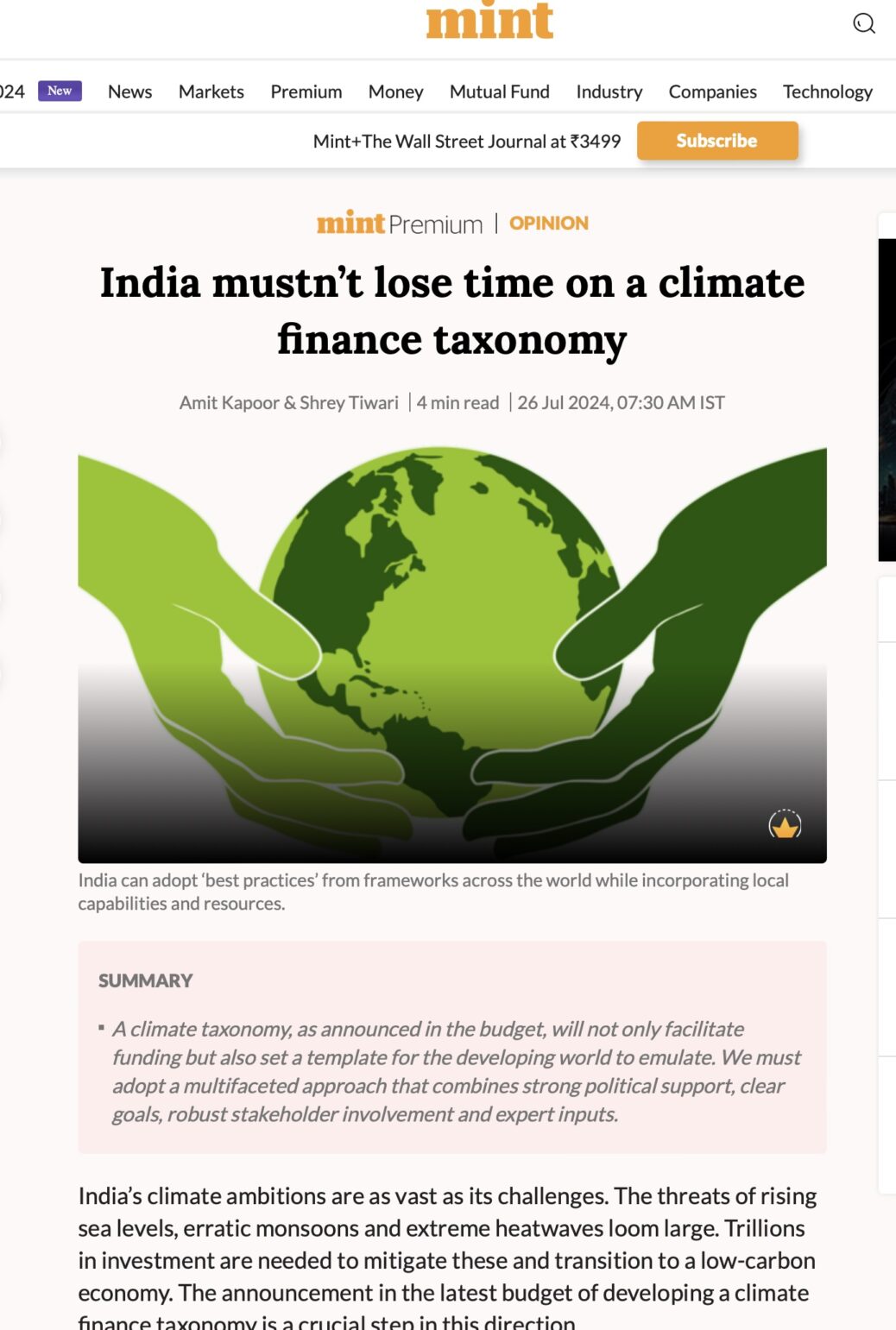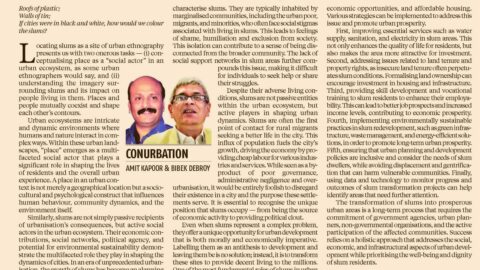By Amit Kapoor and Shrey Tiwari
India’s climate ambitions are as vast as its challenges. The threats of rising sea levels, erratic monsoons, and extreme heatwaves loom large. Trillions in investment are needed to mitigate these impacts and transition to a low-carbon economy. The announcement of the development of a climate finance taxonomy in the Union Budget is a crucial step in this direction. The government aims to unlock a floodgate of private capital, essential for achieving India’s ambitious climate goals, by creating a standardized framework for identifying climate-aligned projects. The taxonomy will be able to achieve this by developing a set of standardized regulations to inform investing actors towards activities or businesses working towards combating climate change.
Development of such a tool would hold immense potential enabling India to meet its ambitious climate targets. As mentioned in the Economic Survey 2023-24, achieving India’s net-zero target by 2070 requires a massive investment far exceeding current domestic and international funding levels. While India has primarily relied on domestic resources for climate action, there is a significant funding gap. Mobilizing global capital for green projects in emerging economies like India is challenging due to perceived risks, lengthy project timelines, and high capital costs. Despite efforts to attract green investments, the Survey notes, India faces a “wall” of capital rather than a “flood”.
Despite being historically low emitters compared to the developed nations, the developing countries such as India are expected to play a delicate balancing act in juggling their economic growth prospects with reduced emissions. A report by the International Finance Corporation estimates that India would require clean energy investments ranging from $253-$263 billion during 2026-30 to align with its immediate climate and sustainable development goals. Significant gaps persist as the current investment available for climate action in the country is only around $44 billion per year. The Report further estimates that India has a $3.1 trillion climate-smart investment potential between 2018 and 2030. Additionally, India’s renewable energy market, valued at $403.7 billion, remains a favorable investment opportunity. Due to governmental push, India has successfully met parts of its Nationally Determined Contributions (NDC) targets for 2030 way ahead of time by reducing the emissions intensity of its GDP by 33% and achieving 40% of installed electric capacity through non-fossil sources. However, sustained financing from both the private and public sector would thus ensure that the country stays on track to achieve its long-term climate goals.
The intention of developing and standardizing the climate finance market at the national level was visible by the establishment of a task force under the Ministry of Finance in January 2021. This task force was assigned the goal of creating a sustainable finance roadmap, a draft taxonomy of sustainable activities, and a risk assessment framework. The Reserve Bank of India in its discussion paper also addressed the country’s climate finance needs of more than $17 trillion to achieve net zero by 2070. Hence, the introduction of taxonomy is a step in the right direction in the country’s fight against the climate crisis.
India stands to gain from the existing frameworks across the world to adopt the best practices while incorporating the local capabilities and resources. As of December 2022, there were more than 29 taxonomies at different stages of development around the world, most notably by the European Union, China, Singapore, ASEAN, and the UK. The taxonomy developed by the EU follows the guiding principle of ‘do no harm’ while covering 6 broad objectives: climate change mitigation, adaptation, sustainable use and protection of marine sources, transition to a circular economy, pollution prevention and control, and protection and restoration of biodiversity and ecosystems. When looking at the developing world, ASEAN proves to be an efficient system incorporating the interest of 10 diverse countries into a singular framework. A tiered framework allows the nations to adopt a level that is suitable for their existing capabilities and allows them to push to the next tier as quickly as possible. Similar to a traffic light system, the levels of green, amber and red tier classifications are based on their impact on the environment.
The diversity in the economic composition of countries along with different geographical contexts bring with them the challenge of a uniform taxonomical structure for activities. What some countries define as a green activity may not be the same for other countries. For instance, the Malaysian Taxonomy endorses palm oil plantations which stands in contrast to the EU’s views that the activity brings with it biodiversity loss. Hence, greater cooperation is also needed for countries to ensure inter-operability between different taxonomies, as also emphasized by the G20 Sustainable Finance Working Group’s 2021 report.
Creating a successful climate finance taxonomy for India would require a multifaceted approach that encompasses strong political leadership, clear objectives, expert involvement, effective governance, and robust stakeholder engagement. Strong political support and active participation from both government and private sectors are essential. A dedicated governance structure, such as a monitoring committee with representatives from key institutions, is crucial for oversight and coordination. Clearly defined climate and environmental objectives would guide the taxonomy’s development and ensure its relevance. Leveraging expertise from international and local experts is also vital. Their combined knowledge would enhance the taxonomy’s quality and adaptability to local contexts. Engaging a wide range of stakeholders through public consultations and market events fosters ownership and addresses potential challenges.
India stands at a crossroads, where economic growth and environmental sustainability must coexist. A well-crafted climate finance taxonomy can be the compass guiding the nation towards a greener future. By aligning financial flows with climate goals, India can not only mitigate climate risks but also unlock immense economic opportunities. The potential rewards of a successful taxonomy are substantial amid challenges. It is imperative that the government, private sector, and civil society collaborate to create a robust framework that can serve as a global benchmark. India’s journey towards a low-carbon economy is ambitious, and with the right policies and investments, it can provide a framework for the developing economies for balancing development goals with climate conscious policies.
The article was published with Mint on July 26, 2024.
























